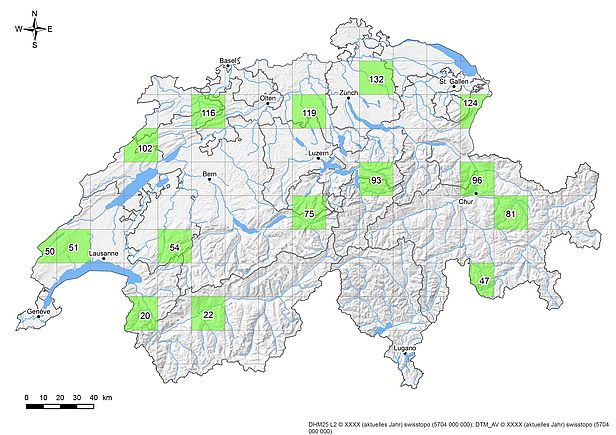Revision of the Red List of endangered lichen species in Switzerland
In autumn 2018, the project Revision of the Red List of Lichens, coordinated by SwissLichens, has started. The aim of the project is to re-evaluate the threat status of all epiphytic and terricolous lichens occurring in Switzerland. Since the first Red List of lichens was published in 2002, the environment has changed, new species have been discovered or described and populations have continued to develop.
The project is expected to continue until 2022. Any help from volunteers is very welcome!
If you are interested, please contact the project manager Silvia Stofer.
Cooperation in 20x20 km test areas
In the project, areas of 20x20 km in size will be searched for lichens during a limited number of days. The aim of the excursions is to detect as many species as possible in the area. All existing habitats are searched for their typical species and an attempt is made to find the most species-rich locations.
SwissLichens staff work on some of these sites, while others (see map below) are available to volunteers.

Local inventories
If you want to search for lichens independently of the 20x20 km areas, you can also choose another area. Areas that you already know well or that you have always wanted to explore in more detail are suitable for this. Ideally, the approach in these areas should follow that of the 20x20 km areas, but personal adaptations are possible.
Check the presence of highly threatened species
If you want to limit the search for lichens to one or a few lichen species, you can visit sites where highly endangered species have been identified in the past. The aim of these visits is to determine whether the population is still present and how it has developed since the last detection.
Reporting of further lichen observations
In addition to the systematic recording of lichen finds, as described above, individual observations of lichens can also be important when estimating the spread or frequency of the species. Whether the lichen is rare or common, whether you discover it at your holiday resort or on the way to work, every observation is valuable! We thank you for submitting your observations to the database.
Processing old lichen samples and data
Maybe you still have notebooks with your observations from 10 years ago lying around at home? Or even a few dusty envelopes or paper bags with collected lichens?
For the assessment of population development and thus the endangered status of a species, past finding sites are of great importance. Use the opportunity of this project to put your carefully collected data to good use!
Workshops for the determination of lichens
In order to support all volunteers on the new Red List, to deepen the common knowledge and to promote exchange between interested parties, regular workshops will be organised between autumn 2019 and spring 2021, to which volunteers can bring their exciting or difficult to identify lichen samples. Together with other interested parties and experts, samples can be discussed and determined. On request, individual difficult lichen groups can also be treated.